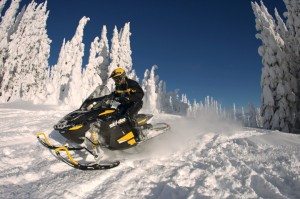Sled market down in North America, up elsewhere
Russia’s growth a strong sign for industry
Brad Darling took seven of his neighbors on a snowmobile outing last winter. None of them had ever been snowmobiling, and after the ride, none of them said they didn’t like it.
“That’s the whole point of this business. You get on one, and nobody gets off,” said Brad Darling, vice president and general manager of the snowmobile division at Arctic Cat. “The key is dress them properly. If you don’t dress them properly, they won’t like it.”
Worldwide, the snowmobile market showed gains during the 2011-12 season despite a lack of snow in much of the U.S. snowbelt. Worldwide sales increased by 5 percent to 129,087 new units sold compared to the 2010-11 season, according to data provided to Powersports Business by the International Snowmobile Manufacturers Association.
Sled sales in the U.S. were down 6 percent to 48,689. Key growth markets in Europe and Russia once again proved fruitful, with a 30 percent increase (40,233 new units) in snowmobile sales in those markets. Canada saw a rise of 1.8 percent in sales, with over 40,000 new units sold.
“The good news is the industry’s up. The challenge we’ve had over the year is that this is a weather-driven business more than it is economics,” Darling said. “Does economics play a factor? Absolutely, but when we get snow, we sell snowmobiles.”
Snow in Russia boosted sales there.
“Russia was up, and that was a big one,” Darling said. “There’s a great opportunity for the snowmobile business in Russia. At one time, if you look back years ago, the Russian market started kind of like the snowmobile business started, as a utility product. Then it slowly started to move into what they call sport models. Russia has a great opportunity that we see as a company and that the snowmobile industry sees it.”

Darling said the North American market was trending nicely early in the 2011-12 season behind sales of crossover sleds and mountain sleds “going into the time frame just before Christmas. Once snow didn’t happen, it started to decline.”
ISMA data also shows the average age of a snowmobile buyer in 2011-12 to be 41 years old.
“That’s a great sign,” Darling said. “We’ve been working on this for a long time and now we’re starting to see that age number decrease. We came off some good snow other than last year, we’re seeing more people staying put and doing more family things, and younger buyers, family buyers, are buying 4-stroke.”
And while the percentage of first-time buyers who bought a pre-owned sled was 65 percent, that number is not a concern to manufacturers.
“It’s a factor of a first-time buyer saying ‘I want to get into snowmobiling, but I don’t want to take the big step into new,’” Darling said. “We see those numbers come into used, and we know they’re going to enjoy it and we know we’re going to get them into new. So that’s exciting for us, absolutely.”
The ISMA data shows that the average snowmobiler rode 900 miles this past year. The majority of snowmobilers in North America are club members and/or association members, according to ISMA. They are active, involved outdoor enthusiasts who build the trails and support snowmobiling freedoms and access. They are also active charity fundraisers who raised over $3.2 million dollars for national charities.








